You’ll need to integrate infrared thermal sensors with PPG heart rate monitors, positioning them strategically on the wrist for ideal skin contact. Select an ARM Cortex-M4 processor for real-time data processing and implement heat spreaders using synthetic graphite sheets to prevent hot spots. Calibrate sensors using blackbody sources for ±0.5°C accuracy, then develop algorithms for biometric authentication and liveliness detection. The complete process involves much more technical detail and optimization strategies.
Understanding Thermal Sensor Integration and Placement Requirements
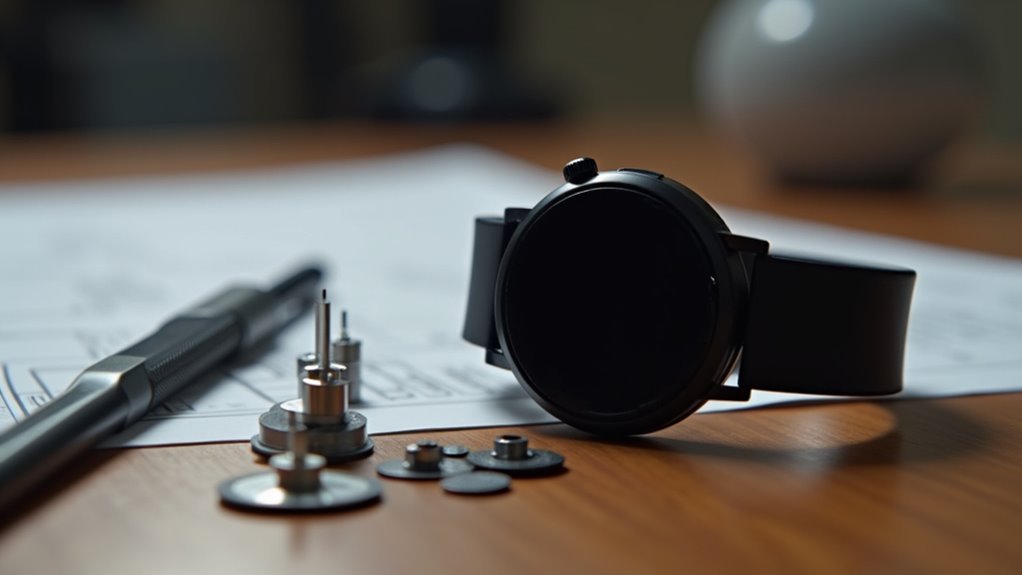
When you’re designing thermal biometric watches, the strategic integration and placement of thermal sensors determines whether your device delivers accurate readings or becomes another unreliable gadget.
You’ll need to prioritize skin contact areas where sensors maintain consistent contact for dependable temperature monitoring. The wrist offers convenient access while guaranteeing continuous measurement capability.
Your sensor placement strategy must balance miniaturization with performance. Ultrathin designs improve user comfort while reducing the device’s thermal footprint.
You’ll want to select materials that’re compatible with both skin contact and electronic components to prevent irritation or interference.
Focus on algorithmic accuracy to guarantee precise temperature measurements from your sensor data. Modern sensors like the LMT70 achieve remarkable 0.13°C accuracy at human body temperatures, making them ideal for medical-grade wearable applications.
Consider environmental factors like external temperature variations and humidity when designing your integration approach for peak performance.
Selecting Biometric Authentication Components for Wearable Devices
Beyond thermal sensors, you’ll need to carefully select biometric authentication components that transform your wearable device from a simple monitoring tool into a secure, personalized platform.
Your component choices should prioritize compact footprints and low power consumption while maintaining authentication accuracy.
Smart wearable design demands balancing miniaturization and energy efficiency without compromising biometric precision or user security.
Consider these essential biometric modalities for your thermal watch:
- Capacitive fingerprint sensors – Offer excellent accuracy in small form factors ideal for wristbands
- PPG sensors – Enable continuous heart rate authentication through blood flow detection
- ECG electrodes – Provide unique cardiac signatures for highly secure identification
You’ll want components with integrated Secure Element NFC chips for encrypted data storage and local on-device verification capabilities.
This approach eliminates network vulnerabilities while supporting contactless payments and access control.
Combine multiple biometric factors to enhance spoofing resistance and overall security. Advanced algorithms and AI integration enable these devices to adapt to unique user needs, establishing baseline health metrics that allow for immediate detection of fluctuations and anomalies.
Designing Thermal Management Systems With Heat Spreaders
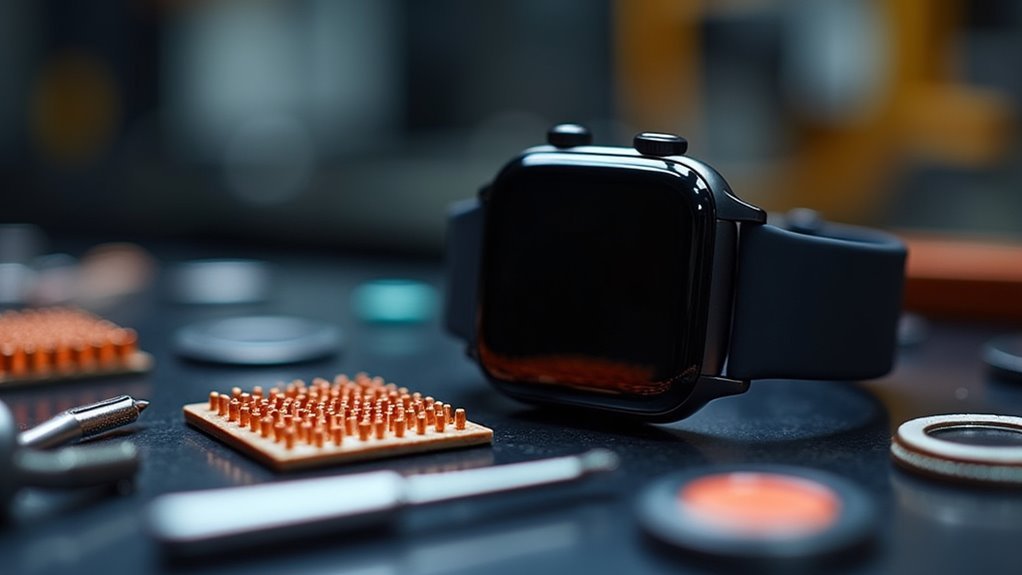
Since thermal biometric watches pack multiple high-power components into compact form factors, you’ll need sophisticated heat spreaders to prevent localized hot spots that compromise both component reliability and user comfort.
Position your heat spreaders between high-density chips and the device enclosure to maximize heat dissipation away from the skin.
Choose synthetic graphite sheets for their exceptional thermal conductivity (1500 W/mK) and ultra-thin profile, or select copper films for consistent performance.
You’ll want materials that balance thinness with effective conduction while maintaining flexibility for wearable comfort.
Design your thermal interface to minimize resistance between components and spreaders.
Use thermal simulation during planning to optimize placement and material selection.
Integrate spreaders within multi-layer architectures for staged heat dissipation, ensuring stable sensor readings and preventing thermal throttling. Consider implementing stacked multilayer composites that guide heat dissipation based on contact interfaces for enhanced thermal management performance.
Implementing Microcontroller and Signal Processing Architecture
You’ll need to carefully select a microcontroller that balances low power consumption with sufficient computational performance for real-time thermal biometric processing.
Your choice must include adequate memory resources and integrated security features like AES encryption to protect sensitive biometric data. The system should incorporate Bluetooth technology for wireless transmission of processed biometric data to external devices or cloud platforms for further analysis.
Once you’ve chosen the right microcontroller, you’ll implement signal processing algorithms that can extract meaningful physiological metrics from thermal gradient measurements while maintaining continuous monitoring capabilities.
Microcontroller Selection Criteria
The microcontroller you select will determine your thermal biometric watch’s performance, power efficiency, and overall user experience.
You’ll want to prioritize ARM Cortex-M series cores, which offer the ideal balance between processing power and energy consumption for wearable applications.
Your MCU must handle complex biometric algorithms efficiently while preserving battery life.
Consider these essential features:
- Integrated DSP capabilities for fast thermal and biometric data stream processing
- Dedicated low-power sensor interfaces to reduce CPU intervention and save energy
- Built-in ADCs with 12-bit or higher resolution for accurate thermal signal digitization
Ensure your chosen MCU operates within -20°C to +70°C, includes sufficient RAM (64KB minimum), and supports multiple communication protocols like I2C and SPI for sensor integration.
Modern controllers integrate analog and digital functionalities in one chip, eliminating the need for separate analog front-end components in your thermal sensing circuit.
Real-Time Data Processing
Implementing real-time data processing in your thermal biometric watch requires a carefully orchestrated pipeline that transforms raw sensor signals into actionable biometric insights within milliseconds.
Your microcontroller must efficiently manage incoming thermal and optical data through analog-to-digital conversion while applying low-pass filters to eliminate Gaussian noise.
You’ll need to integrate peak detection algorithms for identifying vital features like heart rate patterns, combined with Fast Fourier Transform capabilities for spectral analysis.
The processing architecture should include normalization and enhancement steps that standardize data quality, incorporating anti-spoofing technologies to ensure only legitimate biometric readings are processed and stored.
Power management becomes essential here—you must balance computational intensity with battery conservation.
Optimize your algorithms to extract meaningful biometric features while maintaining the sub-second response times necessary for continuous health monitoring functionality.
Algorithm Implementation Strategies
When selecting your microcontroller architecture, prioritize ARM Cortex-M4 or equivalent processors that offer dedicated floating-point units and DSP instructions essential for thermal signal processing.
You’ll need sufficient memory capacity—at least 512KB flash and 128KB RAM—to handle biometric algorithms and data buffering effectively.
Your core algorithm implementation should focus on three critical components:
- Feature extraction algorithms that identify unique thermal patterns using Eigen features or geometric attributes
- Segmentation routines that isolate biometric regions and normalize data for consistent analysis
- Liveliness detection that uses thermal signatures to confirm living tissue presence
Implement threshold-based decision logic for verification acceptance, and guarantee your microcontroller supports integrated ADC and communication protocols like I2C for seamless sensor interfacing and real-time processing capabilities. Consider implementing Fast Wavelet Transform techniques to enhance the robustness of your feature extraction process under varying thermal conditions.
Calibrating Thermal and Biometric Sensors for Accuracy
Calibrating your thermal biometric watch’s sensors forms the foundation for reliable health monitoring, as even minor measurement errors can lead to inaccurate readings that compromise the device’s effectiveness.
You’ll need blackbody sources for thermal sensors to establish accurate temperature benchmarks across controlled ranges like 0–60°C. Connect multiple RTDs to guarantee consistent data while testing under various ambient conditions.
For biometric sensors, collect heart rate and oxygen saturation data at rest and during known activity levels. Compare readings against medical-grade instruments using diverse test subjects across age, sex, and fitness ranges.
Apply statistical analysis like Bland-Altman plots to evaluate accuracy. Document all procedures and schedule regular verification checks to prevent sensor drift, assuring long-term reliability and reproducible results. Ensure the measurement surface completely fills the sensor’s field of view to maintain calibration accuracy throughout the testing process.
Programming Real-Time Data Fusion and Analysis Algorithms
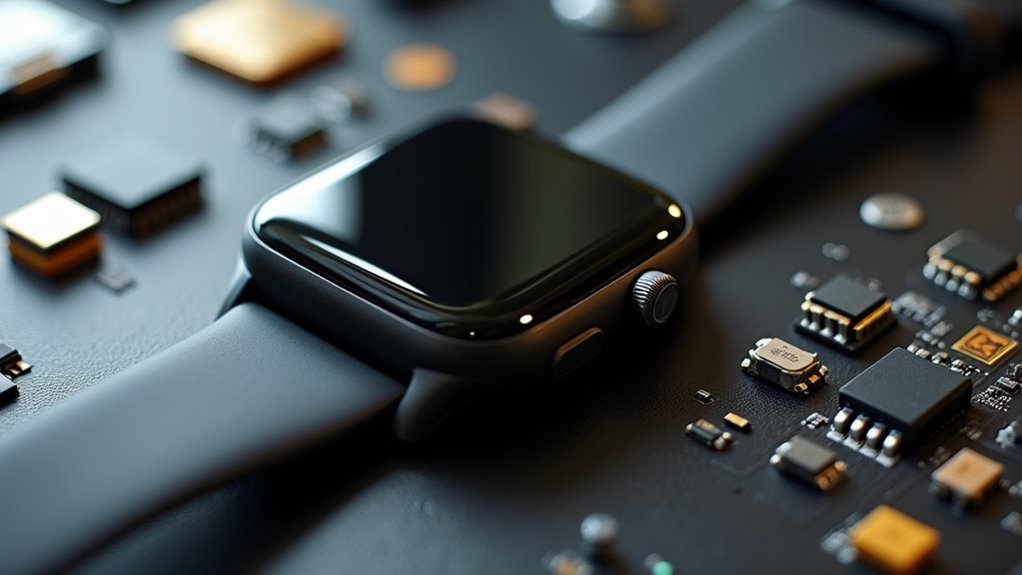
When you’re programming your thermal biometric watch, you’ll need to synchronize data streams from multiple sensors to guarantee coherent real-time analysis.
Your algorithms must handle the challenge of aligning thermal and biometric data that arrive at different frequencies and timestamps.
You’ll also want to optimize these real-time algorithms for computational efficiency while maintaining accuracy in your health monitoring system. Implementing Kalman filters can significantly enhance the reliability of your fused sensor data by compensating for low signal quality and motion artifacts commonly found in compact wearable devices.
Sensor Data Synchronization Methods
Multiple data streams from heart rate monitors, skin temperature sensors, and accelerometers create a complex synchronization challenge in thermal biometric watches.
You’ll need to address timing differences and clock drift that occur due to varied sampling rates and sensor properties.
Event-based synchronization offers the most reliable approach for your thermal biometric watch. You can detect mutual physical events across sensors and use graph models to represent event couplings while minimizing clock drift through shortest-path algorithms.
Consider implementing these key synchronization techniques:
- Use common event timestamps as anchor points for alignment
- Apply dynamic sampling rate adjustments post-event
- Implement biometric activity-based pairing for secure timing
Graph-based synchronization can reduce total drift by up to 43.7%, while event-based methods improve average drift by 60.7%, ensuring accurate real-time analysis. Addressing data model differences across sensor vendors is essential for successful integration and standardized temporal analysis.
Real-Time Algorithm Optimization
Once your thermal biometric watch has synchronized sensor data streams, you’ll need to implement real-time algorithms that can process and analyze this information within milliseconds.
You’ll want to employ machine learning techniques like random forest, KNN, and naive bayes for classification tasks. Utilize metaheuristic algorithms such as GWO, GA, and PSO for feature selection to optimize processing efficiency.
Implement stochastic gradient descent for iterative optimization in your CNN-based systems. You’ll need adaptive feature selection that dynamically adjusts based on real-time data inputs.
Focus on data fusion methods that combine thermal readings with other biometric modalities for enhanced accuracy. Consider implementing curvelet transforms alongside wavelet transforms for feature extraction, as curvelet features have demonstrated superior performance in thermal recognition systems.
Ensure your algorithms achieve high reduction rates in feature selection while maintaining performance.
Test using accuracy, precision, recall, F-measure, and ROC area metrics to validate effectiveness in real-time authentication scenarios.
Ensuring Safety Compliance and Ergonomic Design Standards
As regulations governing workplace safety continue to evolve, thermal biometric watches must meet increasingly stringent compliance standards while maintaining user comfort and safety.
You’ll need to calibrate your device to collect time-stamped environmental and physiological data that satisfies OSHA’s heat stress regulations and similar standards.
Your thermal management design must prevent low-temperature burns by adhering to IEC Guide 117’s surface temperature limits.
Thermal management systems must comply with IEC Guide 117 temperature thresholds to eliminate low-temperature burn risks in wearable devices.
Consider these critical safety elements:
- Heat dissipation systems that prevent device overheating during continuous operation
- Materials that minimize heat transfer to skin while maintaining device performance
- Continuous temperature monitoring to detect and mitigate thermal risks
For ergonomic compliance, optimize your watch’s shape, weight, and strap materials to reduce skin irritation.
Implement moisture-wicking materials and adjustable, hypoallergenic straps that enhance airflow while ensuring long-term wearability without compromising thermal monitoring accuracy. These devices enable proactive safety measures through real-time monitoring that provides critical data for preventing workplace incidents.
Testing Performance Under Various Environmental Conditions
Testing thermal biometric watches across diverse environmental conditions exposes potential performance gaps that could compromise critical health monitoring functions.
You’ll need to evaluate your device under varying temperatures, humidity levels, and altitude changes to guarantee consistent accuracy. Test extreme scenarios including underwater use, high-altitude environments, and severe weather conditions to validate robustness.
Implement standardized testing protocols using environmental simulation tools and data analysis software.
You should utilize monitoring tools like Wet Bulb Globe Temperature (WBGT) meters and heat index calculators to assess thermal performance accurately. Include acclimatization procedures for testers and ascertain material compatibility across all conditions.
Regular calibration techniques and quality control measures maintain reliability, while redundancy systems protect against component failures during environmental stress testing. Consider implementing real-time monitoring capabilities that can provide 24/7 physiological data tracking to enhance the device’s effectiveness during field testing conditions.
Optimizing Power Management and Battery Life Systems
While environmental testing validates your thermal biometric watch’s durability, effective power management determines whether it’ll actually function throughout a user’s day.
You’ll need to analyze power consumption patterns across all components, focusing on thermal sensors and processors that drain energy fastest.
Select low-power components specifically designed for wearable applications. Implement duty cycle optimization to reduce processor activity during idle periods, and choose efficient voltage regulators to minimize conversion losses.
Your battery system requires strategic planning:
- Choose lithium-ion batteries with smart charging algorithms
- Integrate energy harvesting technologies like solar or kinetic systems
- Minimize leakage current in standby modes
Develop power-friendly algorithms that reduce computational intensity while maintaining biometric accuracy. Consider implementing no-touch solutions to reduce power draw from physical contact sensors while enhancing hygiene standards.
Regular software updates can optimize power management protocols, ensuring your device delivers consistent performance throughout extended wear periods.
Frequently Asked Questions
What Manufacturing Costs Should I Expect for Thermal Biometric Watch Prototypes?
You’ll spend £1,500–£6,000 per prototyping run, needing 2–3 rounds typically. Assembly costs $10–$50 per unit, plus $5–$30 for cases and $10–$40 for protective coatings, depending on materials chosen.
How Do I Obtain Regulatory Approvals for Medical-Grade Thermal Biometric Devices?
You’ll need FDA premarket approval by submitting detailed thermal safety data, biometric accuracy testing from accredited labs, and thorough documentation referencing specific docket numbers while ensuring compliance with medical device standards.
Which Wireless Communication Protocols Work Best for Thermal Biometric Data Transmission?
You’ll want Bluetooth Low Energy for power efficiency and real-time data transmission. Wi-Fi Direct offers peer-to-peer connectivity without infrastructure. Both require robust encryption protocols to secure your sensitive thermal biometric data during transmission.
Can Thermal Biometric Watches Interfere With Other Medical Devices or Implants?
You should know that thermal biometric watches can potentially interfere with pacemakers and ICDs if they contain magnets or certain sensing technologies. You’ll need to maintain at least six inches distance from implanted devices.
What Intellectual Property Considerations Apply When Developing Thermal Biometric Watch Technology?
You’ll need to navigate Apple’s extensive wearable biometric patents, conduct thorough patent landscape analysis, guarantee your designs don’t infringe existing thermal sensor patents, and consider licensing agreements for proprietary technologies.
In Summary
You’ve now mastered the complex process of building thermal biometric watches from sensor integration to power optimization. You’ll need to continuously refine your calibration algorithms and thermal management as you encounter real-world usage scenarios. Don’t forget that user safety and comfort remain paramount throughout your design iterations. Your watch’s success depends on seamlessly balancing accuracy, battery life, and ergonomic functionality while meeting industry compliance standards.

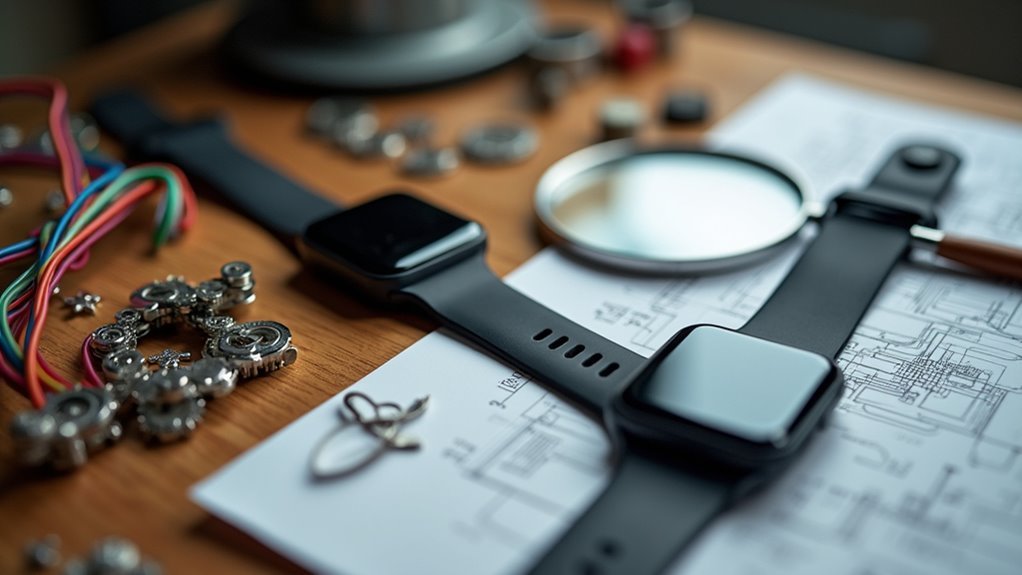
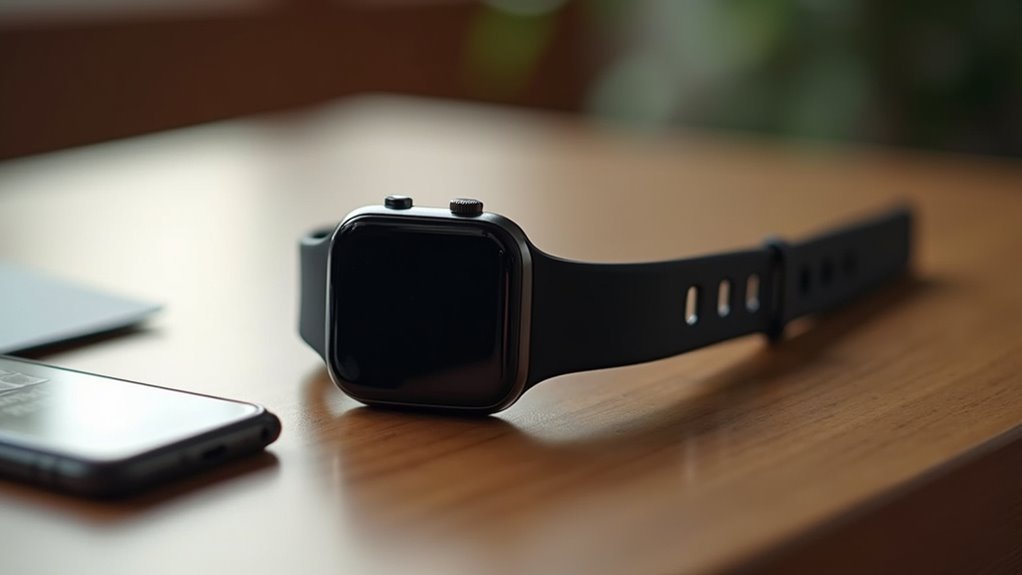
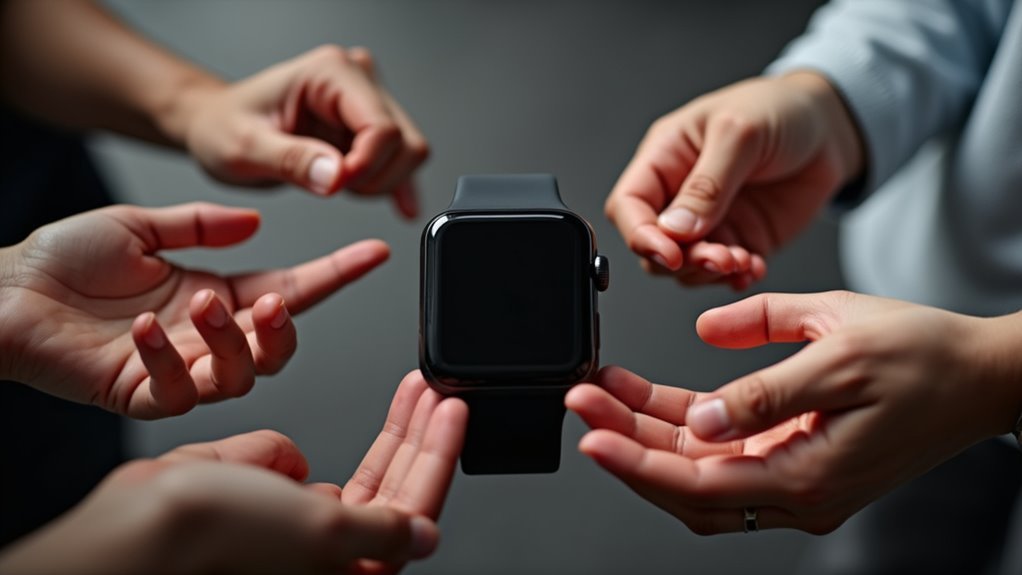
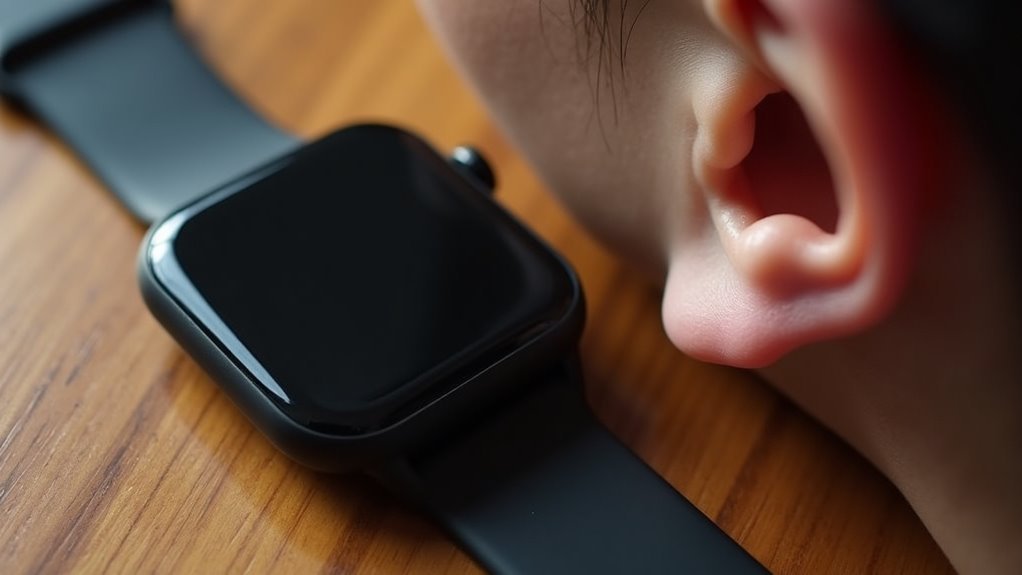
Leave a Reply